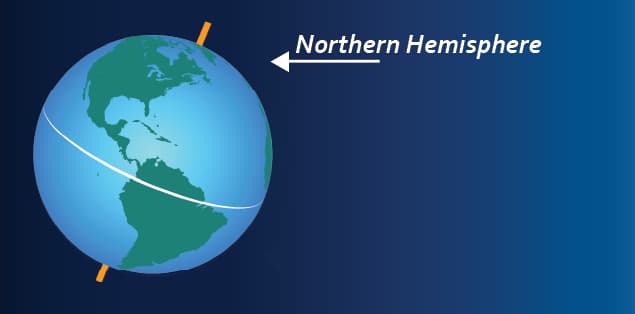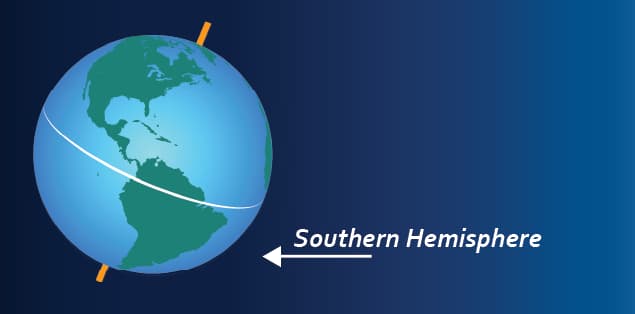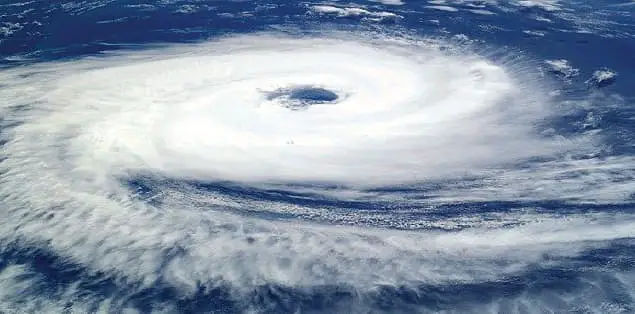You can characterize hurricanes as tropical cyclones that include a rotating system of thunderstorms and strong winds. They originate around the Equator, over warm ocean water. Hurricanes require a warm water reservoir to fuel themselves, which is why they only occur at lower latitudes. “Easterly waves” off Africa, tiny weather systems created by the continent’s heavy summer rains, are frequently blamed.
Anyone who has ever seen a hurricane picture understands that it rotates. The core of the low-pressure center — the “eye” — in the heart of the storm contributes to this. But it’s also a matter of physics. In truth, tropical cyclones are storms called typhoons, hurricanes, or cyclones in different regions of the world, invariably rotates in a counter-clockwise direction in the Northern Hemisphere and the Southern Hemisphere spin is clockwise.
Let us learn in detail – why do hurricanes spin as they are moving?
Why Do Hurricanes Spiral?
The reason is the Coriolis effect, or Coriolis force, which was named after the French mathematician Gaspard-Gustave de Coriolis. It works like this: At the Equator, the planet rotates at a different pace than it does at the North Pole, just like a record on a turntable. The same is true for anything that spins or rotates: the outside edge (in this case, the Equator) spins faster than the interior edge.
Winds going north are deflected eastward in the Northern Hemisphere, while winds moving south are diverted westward. Winds blowing toward the Equator in the Southern Hemisphere will bend eastward, whereas winds blowing toward the South Pole will curve west. When these winds collide, the hurricanes spin clockwise in the south and counterclockwise in the north.
Why Do Hurricanes Spin Like a Pinwheel?
The Coriolis force is part of the reason that hurricanes rotate counterclockwise in the northern hemisphere. The Earth does spin in the mid-latitudes; the Coriolis force causes the wind—and other things—to veer to the right. It is responsible for the rotation of hurricanes. Cooler air replaces warm moist air as it climbs above the sea.
The cooler air will begin to warm and rise as a result. Huge storm clouds arise as a result of this cycle. These storm clouds will begin to rotate in lockstep with the Earth’s rotation, producing a logical system.Warm air continues to rise like a massive chimney, coiling the clouds into a swirling mega-storm. The Earth’s rotation causes a Coriolis effect as the heated air rises.
What Does a Hurricane Need to Form and Grow?
Hurricanes gain strength by absorbing energy from the warm ocean water. A hurricane will continue to build while passing over warm water. Winds travel towards the storm’s center, and the air is driven upward due to low pressure in the center. Winds flow away from the storm high in the atmosphere, allowing additional air from below to climb.
The air that rises must be warm and moist to form the storm clouds. Above warm, tropical ocean waters, you can find warm, moist air. Outside of the storm, you require light winds for a hurricane. These winds are steering the storm, but they aren’t strong enough to stop it, and hence the hurricanes spin counterclockwise in the northern hemispheres.
Why Do Northern Hemisphere Hurricanes Spin Counterclockwise?

Several factors influence hurricane formation. First, they require warm water and warm, moist air, both of which are abundant in the Atlantic Ocean’s central and southern areas. Warm water evaporates and rises in the atmosphere, producing clouds and releasing heat.
As the air rises, it creates a low-pressure zone at the water’s surface. A thunderstorm will emerge if the clouds continue to build up. That low-pressure area will get stronger, drawing additional moist air toward it and intensifying the storm.
For a brief period, they gain extra velocity, which tends to pull them to the right in the direction of the Earth’s rotation. When these fluids go south of the Equator, they keep part of their excess momentum for a short period, which causes them to flow left in the direction of the Earth’s rotation. As fluids approach the Equator from the poles, they reverse the impact because they carry less momentum into higher velocity regions.
Factors Affecting in Counterclockwise Spinning Motion In Northern Hemispheres.
The Coriolis force has a role here. Because “nature abhors a vacuum, and a low-pressure area is a partial vacuum,” Chris Landsea, a Science and Operations Officer at the National Hurricane Center, explained that if there were no Coriolis force, air would rush into the low-pressure center.
In the northern hemisphere, hurricane air movement (winds) goes counterclockwise, while in the southern hemisphere, it moves clockwise. This is due to the Earth’s rotation. The Coriolis force is too weak to move air at the Equator. The Equator is the line that splits the Earth into two halves. The Northern and Southern Hemispheres are the two half of the globe. At the Equator, the Earth is wider.
Why Do Hurricanes in the Southern Hemisphere Rotate Clockwise?

However, because of the Coriolis effect, as winds approach the low-pressure area, they are diverted around and spiral into the center, taking significantly longer for the low-pressure area to fill,” Landsea explained. At the same time, that draws more moist air, which generates more thunderstorms, and you get a massive feedback loop going in a straight line.
The spinning of our planet causes the Coriolis effect. The Earth is constantly rotating or spinning in directions from west to east. The Earth rotates once every 24 hours. However, different parts of the Earth move at different speeds and have different pressure (low and high pressure). Sites closer to the Equator spin quicker than points closer to the poles.
Coriolis Effect on Swirl of Hurricane.
The Coriolis influence helps shape cyclones. Large air masses revolve around a central point in cyclones. Cyclones draw air into their core, or “eye,” as they rotate. Air currents are being pulled in from all sides and slant to the right in the Northern Hemisphere.
The cyclone now spins in the opposite direction. Currents bend to the left in the Southern Hemisphere. Cyclones spin in a clockwise direction as a result. The Coriolis effect influences regular winds. Warm air rises near the Equator, for example, and flows to the poles.
Why Do Tropical Storms Spin Counterclockwise?
Hurricanes in the Northern Hemisphere rotate counterclockwise because of the Coriolis force. However, the Earth spins, and the Coriolis force causes the wind—and other things—to veer to the right in the mid-latitudes. This causes the rotation of hurricanes.
Force of Coriolis. The Coriolis force is proportional to the object’s speed in the rotating frame. It acts in a direction perpendicular to the rotation axis and the body’s velocity in the rotating frame (more precisely, to the component of its velocity that is perpendicular to the axis of rotation).
The observed curving path of moving objects relative to the Earth’s surface is called the Coriolis Effect. Hurricanes are an excellent visual example. The airflow (winds) of a hurricane goes counter-clockwise. This is due to the Earth’s rotation.
Let’s Have Some Physics Concept!
The solid bulk of the Earth’s crust rotates at one revolution each day around its axis. The mass at the Equator travels through space at a speed of about 1,600 kilometers per hour. The mass of the polar regions traverses across space at approximately 0.0000001 km/hour due to the reduced radius (curved path) of rotation at the poles.
The polar areas have substantially less angular momentum due to their smaller radius and lower velocity, as angular momentum is a function of mass, velocity, and radius.
Because of gravity and friction, the enormous sphere’s regional momentum is transmitted to fluids near the surface, but the transfer is not instantaneous. Therefore, when air and water go north of the Equator, they keep some properties.
As a Hurricane Grows, It Changes
A storm travels through several stages as it develops. It all starts with a tropical cyclone. It becomes a tropical depression due to cyclonic circulation and greater wind rates. If the wind speed exceeds 74 miles per hour, it becomes a tropical storm, and if the wind speed exceeds 74 miles per hour, it becomes a hurricane (mph).
The categories are based on the storm’s wind velocity rather than its magnitude. For example, hurricanes that form or appear little on radar can have strong winds. Large storms can also produce low wind speeds. We measure hurricane winds in knots.
Final words – Why Do Hurricanes Spin as They Are Moving?
We’re in the thick of hurricane season, which means that many tropical vacation plans are likely to be shattered by howling winds and swaying palm palms. Typhoons, cyclones, and tropical cyclones are all names for hurricanes, but they all have one thing in common: they spin.
You know what I’m talking about if you’ve ever seen one of those swirly animations of a hurricane crawling from the ocean before making its terrifying appearance on land. Surprisingly, the direction of that spin is determined by which hemisphere the hurricane is brewing in.
